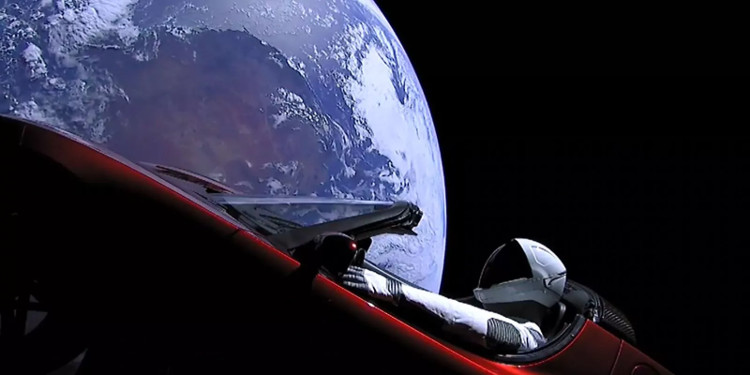Electric vehicles flying to Mars are at risk of being destroyed
Solar radiation and a wide range of objects in the universe can damage the vehicle that SpaceX has taken to space.
The aircraft launched by SpaceX to enter Mars orbit with the Falcon Heavy rocket, the world's strongest rocket, on February 7, may soon be destroyed by solar radiation and objects in the Universe Head, Newsweek reported. Sitting in the driving position is a mannequin named Starman.
Elon Musk, owner SpaceX, hopes the car will survive in space for about a billion years. However, solar radiation and cosmic objects can greatly damage the car earlier than this time. It may not even last a year, according to chemist William Carroll at Indiana University.

The car can be quickly damaged by extraterrestrial effects.(Photo: South China Morning Post).
In the universe there are many floating objects, from micro-meteorites to asteroids. While avoiding the collision with large objects, the car is also difficult to avoid small pieces of rock, Carroll said.
Another threat is solar radiation. Humans are protected from most solar radiation and cosmic rays thanks to the Earth's atmosphere and magnetic fields. But out of space, the car will not have this shield protected.
"All organic things can be destroyed by many types of radiation out there," Carroll said. This means that all plastic parts and carbon fiber frames of the car are also affected. Carbon-carbon bonds and carbon-hydrogen bonds can weaken under high energy of radiation. When these links are broken, the Tesla Roadster may be broken to pieces.
The links will break randomly and gradually, every organic part of the car will decay. Finally, the car will remain inert with inorganic parts like the aluminum frame."In that environment, I don't think organic parts will float over a year," Carroll said.
- Singapore unmanned electric vehicle test
- Electric vehicles can be charged and charged on the road
- TF-X flying vehicles are licensed to test on US airspace
- SpaceX electric car carrying Starman mannequin flies over Mars
- Development of electric vehicles without batteries, taking electricity from the road surface
- Electric cars are more polluting than gasoline vehicles
- Unmanned trains in Russia
- Electric cars can reach speeds of 300km / h
- There is going to be an electric vehicle
- Unique electric car with bamboo friendly environment
- China announced the Mars probe model
- In 2010, the 'science city' will use electric cars
 Van Allen's belt and evidence that the Apollo 11 mission to the Moon was myth
Van Allen's belt and evidence that the Apollo 11 mission to the Moon was myth The levels of civilization in the universe (Kardashev scale)
The levels of civilization in the universe (Kardashev scale) Today Mars, the sun and the Earth are aligned
Today Mars, the sun and the Earth are aligned The Amazon owner announced a secret plan to build a space base for thousands of people
The Amazon owner announced a secret plan to build a space base for thousands of people